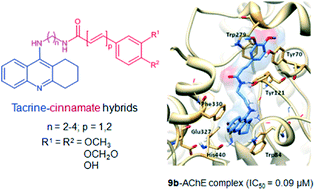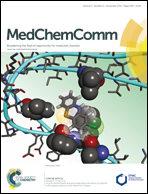Design, synthesis and bioevaluation of tacrine hybrids with cinnamate and cinnamylidene acetate derivatives as potential anti-Alzheimer drugs†
Abstract
A series of novel tacrine–cinnamate and tacrine–cinnamylidene acetate hybrids have been designed, synthesized and evaluated as multitarget compounds for the treatment of Alzheimer's disease. Results of the assessment of their inhibitory activity against acetylcholinesterase (AChE), antioxidant activity and self-induced β-amyloid (Aβ) aggregation are reported. These hybrid compounds showed promising results: all presented high activity against AChE, with IC50 values between the low micromolar and nanomolar range of concentrations. The molecular modeling studies suggested dual interaction with both the catalytic and peripheral sites. Some compounds presented good antioxidant activity (DPPH free radical method) in the low micromolar range, namely the cinnamate derivatives with hydroxyl substituents and extended allyl-conjugation. Moreover, these compounds showed good neuroprotective effects by rescuing neuroblastoma cells stressed with the β-amyloid peptide and hydrogen peroxide. Overall, our results suggest that some of these new hybrids have good potential as multifunctional drug candidates for AD treatment.


 Please wait while we load your content...
Please wait while we load your content...